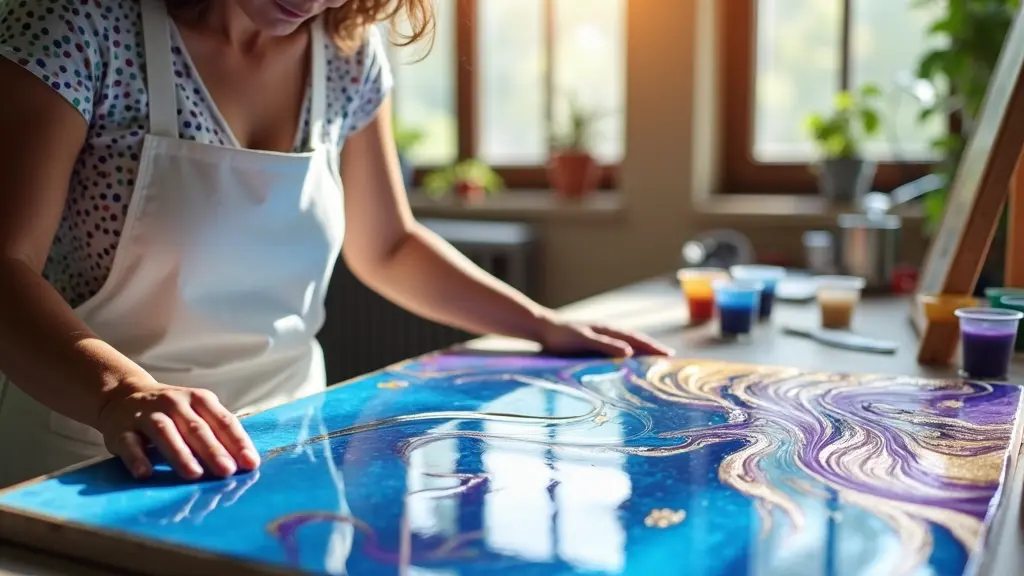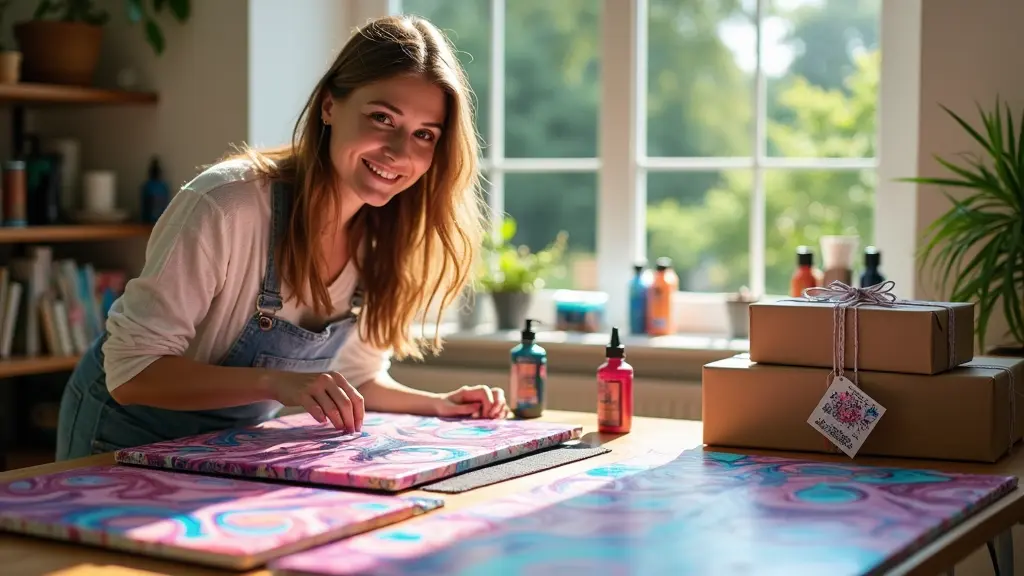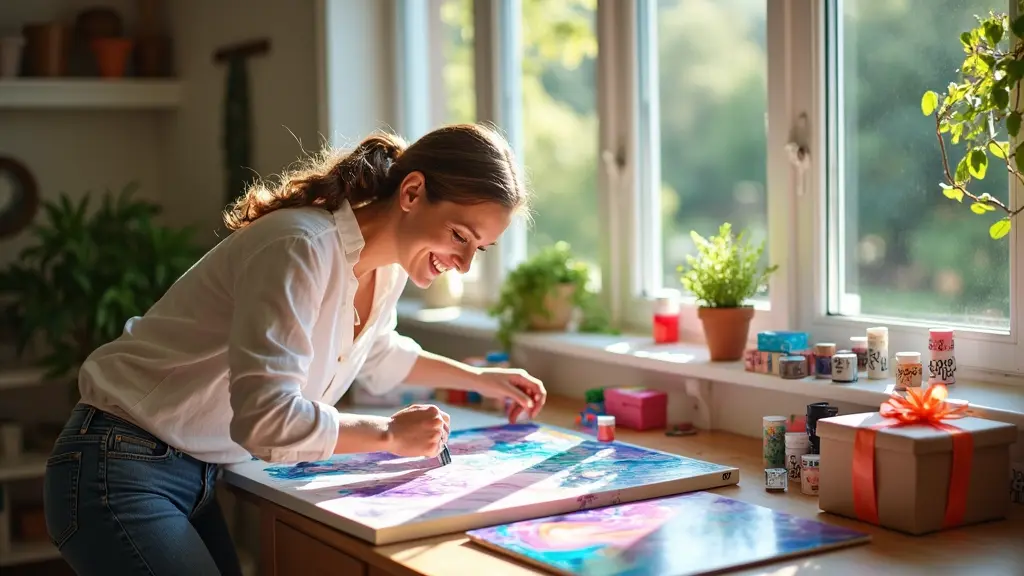Drawing With Pencils Sparks Creativity And Joy
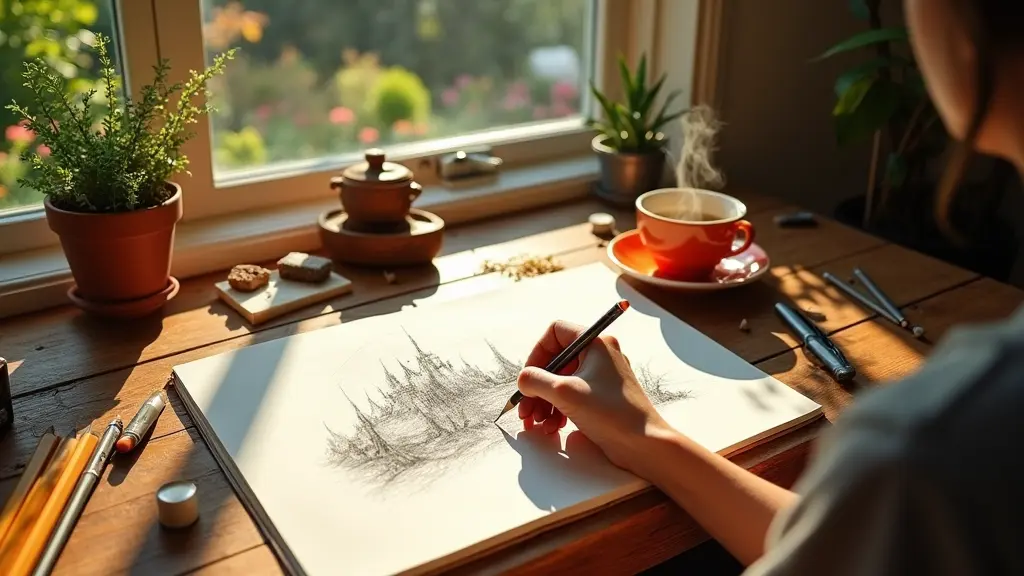
As we embark on a creative journey, pencil drawing instantly transports us to a realm of limitless possibilities, where artistic expression knows no bounds. With pencils in hand, we can conjure a world of vibrant colors, inviting textures, and delicate nuances, all while traversing the vast expanse of graphite shading.
Pencils are an essential tool for any artist, offering a range of expressive lines, from delicate and precise to bold and gestural, sparking a sense of playfulness and imagination.
Unlike digital tools, pencils provide a tactile experience, connecting us to the physical act of creating and exploring textures and mediums. This unique combination allows us to experiment, make mistakes, and learn from them, fostering a lifelong passion for creative expression.
Getting Started With Pencil Drawing
The magic of creating something from nothing is a feeling that never gets old, and with pencil drawing, this magic is within your grasp.
Discovering the Joy of Pencil Drawing
Understanding the benefits and rewards of starting a pencil drawing journey
Pencil drawing is a great way to relax and express yourself creatively, and it’s also an excellent way to improve your fine motor skills and hand-eye coordination.
As you practice, you’ll find that your perspective on the world shifts, and you’ll notice the tiny details that make life so beautiful. Choosing the Right Tools and Materials
Familiarizing yourself with different types of pencils and graphite
A good grip on your pencil, much like a good grip on perspective, is essential for achieving smooth, even strokes, and understanding the nuances of still life practice, portrait rendering, landscape illustration, and texture creation.
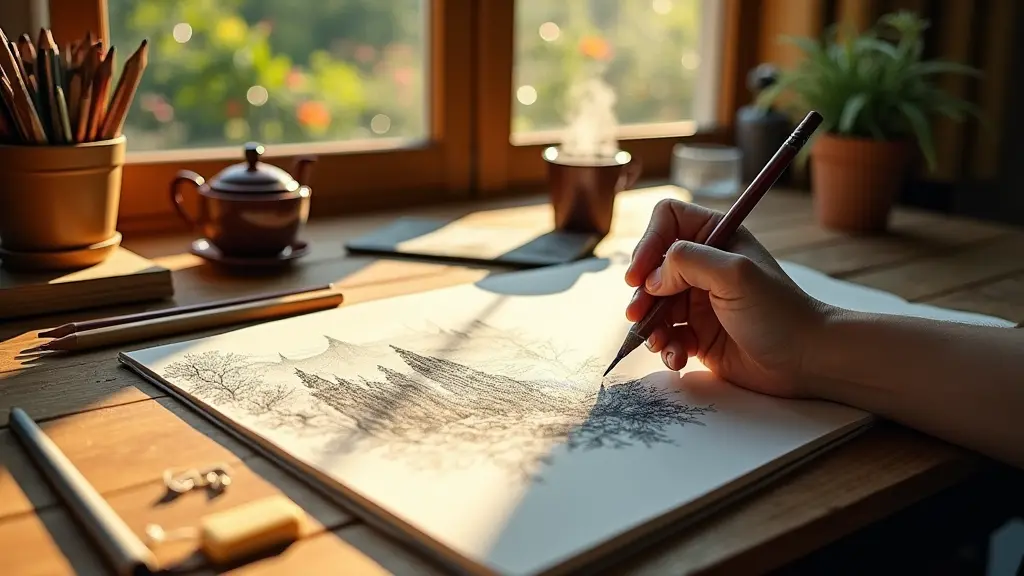
Unleashing Your Inner Artist Through Sketching
As we navigate the complexities of modern life, it’s easy to lose touch with our creative sides. By incorporating simple sketching techniques, such as crosshatching, into our daily routines, we can reignite our inner spark and unlock a sense of fulfillment.
Sketching as a form of artistic expression has a rich history, dating back to ancient civilizations where it was used to record observations and document daily life.
Today, sketching is a popular hobby and tool used by artists, designers, and anyone looking to tap into their creative potential.
The benefits of sketching are numerous, from reducing stress and anxiety to fostering creativity and improving observation skills. When we take the time to sketch, we become more mindful and present in the moment, quieting our minds and focusing on the gesture of life around us. Blending stumps and eraser techniques are often used to refine sketching skills, particularly when creating tonal value studies and contour lines that accurately convey the subject’s gesture.
Benefits of Sketching
- Sketching can reduce stress and anxiety.
- Sketching can foster creativity and improve observation skills.
- Sketching can help individuals become more mindful and present in the moment.
- Sketching can refine skills through techniques such as blending stumps and eraser techniques.
Mastering Basic Graphite Shading Techniques
As we strive to create drawings that capture our audience’s attention, it’s crucial to develop observational skills that translate visual observations into effective compositions. By mastering the art of graphite shading, artists can imbue their subjects with depth, dimension, and a sense of realism.
Effective use of value and contrast is fundamental to creating convincing shading.
By varying the lightness and darkness of an image, artists can create a sense of volume and dimension, drawing the viewer’s eye to specific areas of the piece.
Fundamentals of graphite shading include the basic strokes and techniques, such as lines and hatching, cross-hatching and stippling.
These techniques can be used to create different textures and effects, adding depth and interest to a drawing. are covered to create a strong foundation for 3D modeling.
How To Create Expressive Line Art
Unlocking Your Creative Potential Through Artistic Expression Developing your artistic skills through expressive line art can unlock a world of creative possibilities. By embracing the freedom of freehand sketches, you can tap into your imagination and bring your most vibrant ideas to life.
Introduction to Expressive Line Art
Leveraging the Power of Line Art to Convey Emotion
Expressive line art is a powerful medium for conveying emotions and telling stories.
By mastering the art of freehand sketches, you can create imaginative and dynamic pieces that stir the soul.
Understanding the Basics of Line Quality
Finding Your Unique Line Style
Line quality is a crucial aspect of expressive line art. It encompasses the weight, texture, and movement of your lines, which work together to create a unique visual language. With hand-eye coordination and artistic confidence, you can refine your expressive markmaking, freehand, imaginative sketches, and paper selection.
Exploring Visual Storytelling With Pencils
Relaxation through creativity, pencil drawing has a unique ability to unwind the mind while crafting a visual narrative. As a dynamic medium, it invites us to slow down, be present, and let our thoughts flow onto the paper.
I.
Introduction
Defining Visual Storytelling
Visual storytelling is the art of conveying a message, idea, or emotion through a combination of visual elements, such as images, graphics, and nature sketching.
It is a powerful tool for communication, allowing individuals to share their thoughts, experiences, and perspectives with others in a way that resonates deeply. We will explore the role of pencils in visual journaling.
Developing Your Unique Artistic Style
As artists, we’re often drawn to the works of others, not just for their technical skill, but for the unique voice and perspective that shines through. Yet, developing our own distinctive artistic style can seem daunting, like navigating a creative maze without a clear path forward.
Understanding the Importance of Style Development
Artists often struggle with the idea of developing a unique style, fearing that it may limit their creativity or stifle their growth.
The opposite is true.
A distinctive style provides a sense of direction and stability, allowing you to focus on refining your craft.
Technique and Expression: The Foundation of Style
Hatching, for instance, involves creating detailed renderings by alternating rows of parallel lines, adding texture and depth to your art. By mastering the techniques of detailed renderings, hatching, stippling, and smudging effects, and incorporating pressure control and style development, artists can.
Key Points on Developing a Unique Artistic Style
- A distinctive style provides a sense of direction and stability, allowing artists to focus on refining their craft.
- Mastery of techniques such as hatching, stippling, and smudging effects can help artists develop their unique style.
- Developing a unique style does not limit creativity, but rather provides a foundation for artistic growth.
- Pressure control and style development are essential elements in creating a distinctive artistic style.
Enhancing Creativity Through Observational Skills
I am waiting. Introduction**
As we navigate the complexities of life, it’s easy to overlook the subtle yet profound moments that surround us.
By embracing mindfulness and focusing on the smallest details, we can unlock a world of creative potential.
Elevating our self-expression and sparking inspiration often begins with a gentle nudge in our daily routines, a reminder to slow down and pay attention to the world around us.
The Power of Observation
Observation is the spark that sets the creative process ablaze, fueling innovative thought and guiding artistic expression.
When we truly see, rather than merely glance, we uncover the intricate tapestry of life, imbued with stories, textures, and nuances waiting to be translated into something new and original. To incorporate mindfulness, self-expression, inspiration, and prompts into your daily routine, make sketchbook habits a priority and keep necessary supplies at your fingertips.
Why Is Drawing Therapeutic?
The art of drawing has long been recognized as a valuable tool for promoting overall well-being, and its therapeutic benefits are becoming increasingly well-documented. Maintenance of positive mental health is no easy feat, and finding healthy ways to manage stress and anxiety is crucial for our daily lives.
Mindfulness and Relaxation: Drawing encourages mindfulness, allowing individuals to focus on the present moment and quiet their minds.
This mindfulness can lead to a sense of relaxation, reducing stress and anxiety.
By dropping our worries about the past or future, we can engage fully with the creative process, exercising our minds and promoting a sense of calm.
Prolonged periods of stress can lead to problemsolving difficulties, including difficulty concentrating and decreased productivity. Drawing has been shown to improve focus and attention, allowing individuals to better manage stress and maintain their daily routines through a combination of exercises promoting growth, facilitating problem-solving, and enhancing visual communication within a supportive community.
Drawing With Charcoal Sparks Joy And Creativity
Oil Painting Tips Spark Joy And Creativity
Oil Painting Tips Spark Joy And Creativity
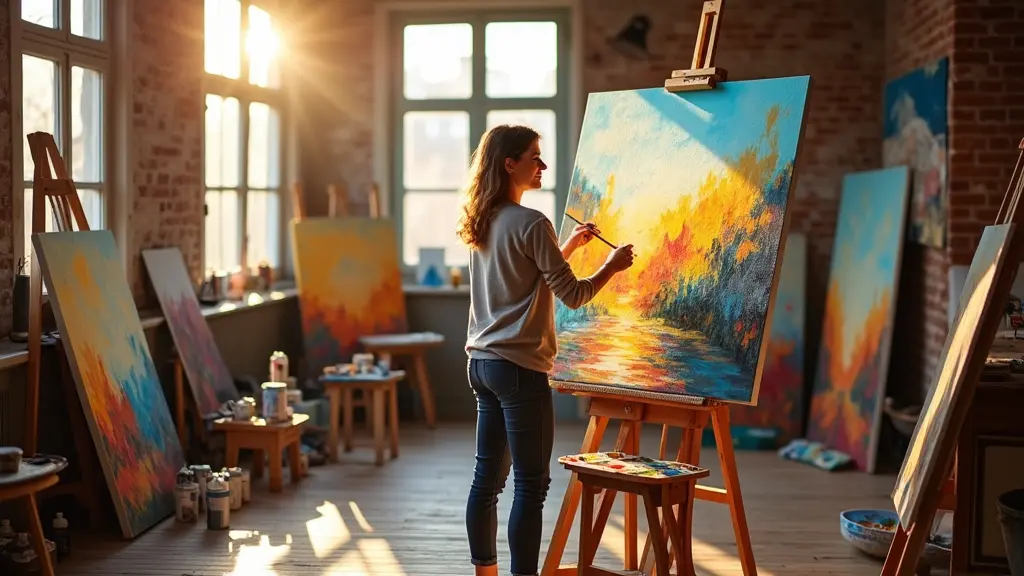
Unlocking the Secrets to a More Fulfilling Life through Art. With its rich textures and vibrant colors, oil painting offers a unique way to express yourself and tap into your imagination.
Combining the tactile experience of canvas with the fluidity of brushstrokes, oil painting provides an immersive and meditative experience that can transport you to a state of serenity.
As you become lost in the process, you’ll discover a sense of accomplishment and pride in your creations. Canvas, brushes, palette, and easel are the foundation of an artist’s setup, while understanding color mixing and texture techniques is crucial for achieving the desired effect.
Getting Started With Canvas Fun
When you surrender to the allure of artistic expression, a blank canvas can be both liberating and intimidating. It’s during these moments that the right tools and techniques can make all the difference.
Welcome to Canvas Fun
Why choose Canvas Fun for your next creative project? Canvas Fun offers a range of benefits that cater to both beginners and experienced artists.
By using our canvas, you’ll discover a world of endless possibilities, from bold brushstrokes to vibrant colors.
Preparation is Key
To achieve a masterpiece, it’s essential to establish a solid composition on your canvas. Start by choosing the perfect perspective, considering the scale and complexity of your project.
Next, select the ideal blending tools, allowing you to layer your colors with precision and control. Discover Your Creative Voice with Canvas Fun, where you can experiment with composition, perspective, blending, layering, glazing, and impasto techniques.
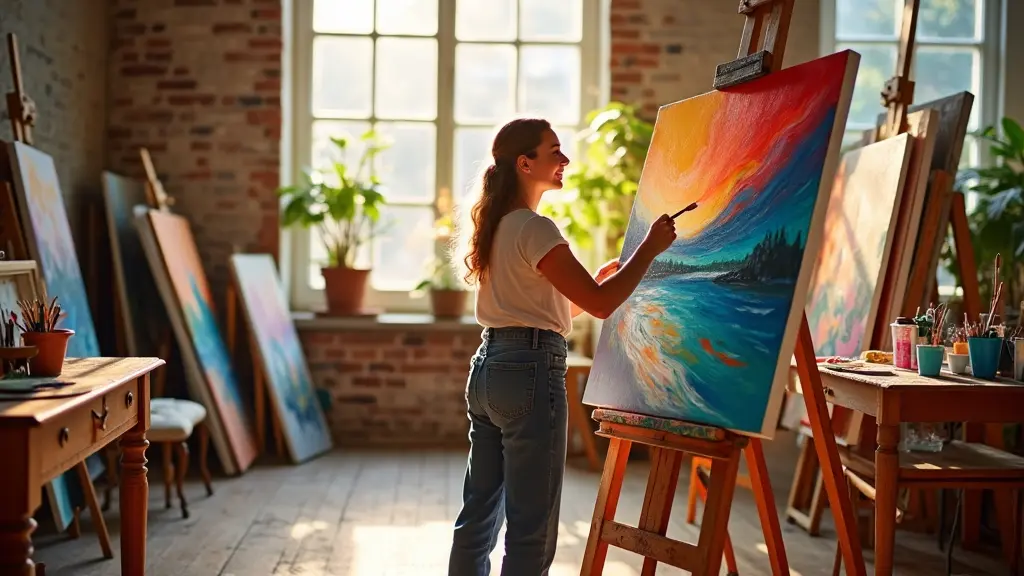
Exploring Joyful Color Mixing Techniques
In the world of oil painting, few things evoke joy and excitement like the discovery of a harmonious color combination. When done thoughtfully, joyful color mixing can transport viewers into a world of depth, emotion, and connection.
For oil painters, mastering this technique is essential for capturing the essence of their subjects, whether it’s the soft glow of a still life setup or the dramatic play of light on a landscape.
Understanding the importance of color mixing in oil painting
Color mixing is a fundamental aspect of oil painting, allowing artists to create an astonishing range of colors and effects.
By grasping the fundamental principles of color theory, artists can begin to experiment with different techniques to achieve the desired mood and atmosphere in their work. Joyful color mixing can add a level of realism to a painting, making it more engaging and dynamic by capturing the contrasting effects of chiaroscuro.
Color Mixing in Oil Painting
- Color mixing is a fundamental aspect of oil painting, allowing artists to create an astonishing range of colors and effects.
- Understanding the fundamental principles of color theory is essential for mastering the art of joyful color mixing.
- By grasping the principles of color theory, artists can experiment with different techniques to achieve the desired mood and atmosphere in their work.
- Joyful color mixing can add a level of realism to a painting, making it more engaging and dynamic by capturing the contrasting effects of chiaroscuro.
Why Choose Oils For Expression?
The tactile experience of oil painting offers an unparalleled forum for creative expression, allowing artists to transport themselves to a world of imagination and inspiration. With its rich, vibrant colors and texture, oil painting provides a multisensory experience that sparks creativity and fosters artistic growth.
Why Choose Oils For Expression?
Fundamentals of Oil Painting.
Oil painting has a rich history dating back to the 12th century, with artists like Leonardo da Vinci and Vincent van Gogh creating iconic masterpieces using this medium.
Understanding the basics of oil painting, including the pigment, binder, and solvent composition of oil paints, is essential for any artist looking to create high-quality work. By mastering techniques such as medium selection and brush care, artists can unlock the full potential of oil painting, creating stunning impressionist pieces that radiate light and energy.
Brushes: Your Creative Companions
The evolution of art is intricately tied to the art of brushwork, with the subtle nuances of linseed oil-infused strokes shaping the course of creative expression. From the earliest cave paintings to the intricate masterpieces of modern times, the humble brush has played a pivotal role in the artistic process.
Brushes: Your Creative Companions
Level 1: Understanding Brush Basics
Natural, synthetic, and hybrid brushes cater to diverse artistic needs and styles.
Types of Brushes
Natural brushes, made from animal hair or plant fibers, imbue artworks with organic warmth and texture. Synthetic brushes, crafted from nylon, polyester, or other materials, offer uniformity and durability, often paired with turpentine to achieve a smooth, even finish.
Composition: Crafting Visual Stories
When weaving a tapestry of emotions, artists rely on a subtle balance of elements to guide the viewer’s gaze. By harnessing the power of subtle tonal values, an artist can evoke a captivating atmosphere, drawing the audience in with an invisible thread.
Rembrandt, a master of chiaroscuro, skillfully manipulated light and dark to craft a sense of drama, his brushstrokes dancing across the canvas like warm tones on a summer breeze.
Understanding the Power of Composition
Composition is the foundation upon which visual storytelling is built.
By carefully considering the placement of elements within a painting, an artist can guide the viewer’s eye and evoke a specific emotional response. For instance, a master such as Rembrandt harnessed the power of composition to create a sense of drama and tension in his works, often using sfumato to blend chiaroscuro with warm tones.
Texture Techniques For Artistic Freedom
When we surrender to the emotional depth of art, we discover a world of limitless expression. Texture techniques offer a gateway to this artistic freedom, allowing us to tap into our deepest feelings and bring them to life on canvas.
Texture Techniques For Artistic Freedom.
- Introducing the Power of Texture: Unlocking Creativity
-
Exploring the role of texture in art.
By incorporating cool hues and expressive techniques, artists can convey a sense of atmospheric effects that transport viewers to a world of emotional resonance. Through focus on negative space, we can create a sense of gestural painting that draws the viewer in, making them feel like an active participant in the art. The artist’s use of cool hues, expressive techniques, gestural painting, atmospheric effects, and deliberate placement of the focal point amidst the negative space creates a captivating visual experience.
Embracing Mistakes In Alla Prima
Artistic expression is often masked by the pursuit of perfection, which can result in a lack of depth perception and a rigid approach to creation. By embracing imperfection, we can tap into the joy of creative flow and discover the beauty in the unexpected.
Alla Prima, a centuries-old painting technique, has been a cornerstone of artistic expression for many masters.
This direct and spontaneous method of painting emphasizes capturing the essence of the subject rather than creating a flawless representation.
Mistakes are an inevitable part of the creative process, and alla Prima is no exception. In fact, some of the most renowned artists in history, such as Vincent van Gogh and Pablo Picasso, have highlighted the importance of embracing errors as a means to unlock inspiration. While shadows of doubt may initially fall upon our work, they can ultimately serve as a catalyst for growth and tap into the depths of our creative flow, sparking highlights of artistic expression and new sources of inspiration.
Finding Your Unique Painting Voice
As creatives, we’ve all experienced the thrill of unlocking our unique voice, whether it’s through writing, music, or visual art. But in the world of oil painting, where precision and technique are paramount, finding that distinctive voice can be a daunting task.
Embracing experimentation is crucial in discovering your distinctive painting voice.
By taking risks and trying new techniques, you’ll unlock a path of growth and artistic progression.
When looking to refine your skills, focus on the joy of creating rather than striving for perfection. By doing so, you’ll cultivate a sense of mindfulness that will guide your brushstrokes and infuse your artwork with authenticity, allowing you to truly relax and tap into your own relaxation.
Remember, your unique painting voice is a reflection of your personality, experiences, and artistic self-discovery. By staying true to yourself and cultivating your vision, selfdiscovery, relaxation, mindfulness, and growth through experimentation,.
Drawing With Pencils Sparks Creativity And Joy
Watercolor Painting Projects Spark Joy And Creativity
Watercolor Painting Projects Spark Joy And Creativity
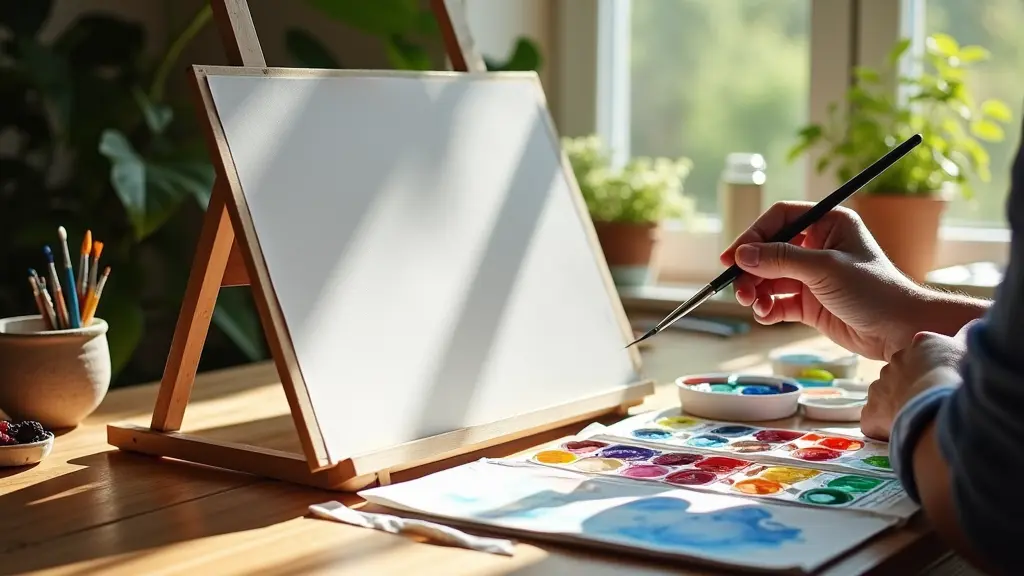
Creativity is a thread that weaves its way through the tapestry of our daily lives, awakening new perspectives and emotions. When indulged in watercolor painting, this thread is woven into a rich fabric of joy and fulfillment.
Watercolor Painting Projects offer a serene escape from the ordinary, providing a calming and meditative experience that can melt away stress and anxiety.
This is due to the soft, soothing quality of brushstrokes and pigments that harmonize to create a sense of balance.
As you delve into the world of watercolor painting, you’ll discover that color theory is the backbone of creating harmonious and visually stunning pieces. By mastering the art of palette mixing and understanding how to balance colors, you can achieve stunning and unique pieces of art that showcase your artistic skill and creativity.
Getting Started With Brushstrokes Basics
Watercolor painting is a captivating form of artistic expression that allows individuals to tap into their creativity and express themselves freely. By focusing on the fundamentals, artists can create stunning pieces that showcase their unique perspective.
I.
Introduction
Setting the stage for watercolor painting projects with a focus on basics is essential for any artist, as it provides a solid foundation for experimentation and growth.
II.
Unlocking the Power of Brushstrokes
Brushstrokes are the foundation of watercolor painting, and understanding their importance is crucial for creating stunning artworks that evoke emotions and tell stories.
III. Mastering the Fundamentals
There are various types of brushstrokes, including salt effects, that artists can use to add texture and depth to their paintings. Washes, for instance, can be used to create subtle layering and subtle salt effects by applying masking fluid to specific areas of the composition in a still life painting.
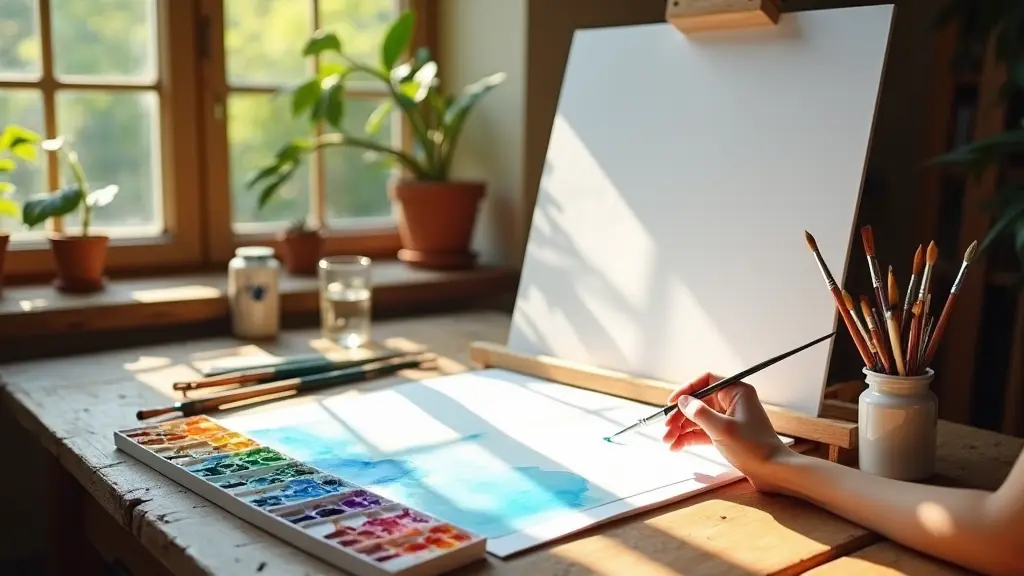
Exploring Vibrant Pigments And Palettes
The Power of Vibrant Pigments and Palettes In a world where artistic expression is a fundamental aspect of our humanity, vibrant pigments and palettes have the ability to transport us to a new dimension, where creativity knows no bounds. When we immerse ourselves in a kaleidoscope of colors, we are not just creating something beautiful, but also opening ourselves up to a world of emotional depth and psychological complexity.
Vibrant colors have been a cornerstone of creative landscape for centuries, playing a significant role in shaping cultures and sparking emotions.
From the expressive brushstrokes of abstract expression to the intricate details of botanical illustrations, color has been a fundamental element of various artistic movements.
Research has shown that vibrant colors can have a profound impact on our emotional and psychological well-being. Studies have found that exposure to bright, abstract expression colors can stimulate creativity and inspire artistic expression in activities such as landscape painting, botanical illustrations, creative workshops, and art journaling, and even mindful painting.
Mastering Washes For Dreamy Effects
Unlocking the Secrets of Ethereal Textures. By mastering artistic techniques that allow for subtle shifts in tone and hue, artists can create dreamy effects that transport viewers to another realm.
What are Washes?
Washes are a fundamental watercolor technique that involves applying transparent pigments to create soft, blended edges.
Unlike other techniques, washes involve building up layers of pigment to achieve a desired effect.
This approach is particularly effective in creating dreamy, ethereal textures that capture the viewer’s attention.
Working with Transparent Pigments
To achieve dreamy effects, artists must work with transparent pigments that allow for subtle layering and blending. This requires a thoughtful approach to color selection, as even the slightest variation in these artistic elements – tutorials, artistic exploration, expressive techniques, blending, negative space, and loose style – can dramatically alter the overall effect.
Layering Techniques For Rich Depth
Watercolor painting is an art form that thrives on the subtlety of light and shadow, beckoning us to explore the depths of its translucent hues. When executed with finesse, layering techniques can transport us to an ethereal world, where every brushstroke whispers secrets of the painter’s hand.
Understanding the Basics of Layering
Layering is a fundamental concept in watercolor painting that involves applying multiple layers of translucent paint to achieve desired colors, textures, and effects.
Building Up Layers for a Rich Visual Experience
Mastering the art of layering requires a consistent approach, where every stroke echoes the previous one, weaving a tapestry of texture and tone.
By doing so, you can create a visual narrative that draws the viewer in, inviting them to linger on the subtleties of the composition.
How To Create Expressive Landscapes
The world of art is a realm where emotions are stirred, and the imagination knows no bounds.
Understanding the Power of Expressive Landscapes
The world of art is a realm where emotions are stirred, and the imagination knows no bounds.
A skilled artist can harness this power to craft landscapes that resonate deep within the viewer, evoking feelings of serenity and harmony.
By tapping into the emotional connection between art and audience, expressive landscapes can transcend the boundaries of reality, creating a sense of self-discovery and introspection.
Gathering Inspiration for Your Landscape
A stroll through a sun-drenched meadow, with its gradient effects of warm light and gentle shadows, can be a profound source of inspiration for expressive landscapes. As you observe the harmony between the colors, textures, and forms, you begin to recognize the intricate play of light and atmosphere, where gradient effects blend seamlessly with atmospheric perspective to reveal a visual language that embodies the essence of experimental approaches, playful exercises, and self-discovery.
Unleashing Creativity Through Abstract Expression
Unleashing Creativity Through Abstract Expression Immersive growth of imagination is fueled by fluid movements on the canvas, as artists embark on a therapeutic hobby that transports them to imaginative scenes. By exploring abstract expression techniques, you can break free from traditional art constraints and unlock a world of creative possibilities.
This intuitive approach allows the color wheel to guide the selection of vibrant hues, as texture techniques come to life with every brushstroke.
As artists delve deeper into the world of abstract expression, they discover a sense of therapeutic release, allowing their emotions to flow freely onto the canvas.
The process becomes a meditation, with the strokes of the brush serving as a form of self-expression. By embracing the unknown, artists can tap into their inner creativity, unlocking a world of imaginative scenes that defy traditional boundaries. Abstract expression is not just a form of art, but a journey of self-discovery through fluid movements, imaginative scenes, and therapeutic hobby, allowing for growth, exploration of texture techniques, and harmonious color wheel manipulation.
Abstract Expression
- Abstract expression techniques allow artists to break free from traditional art constraints.
- The process of abstract expression can serve as a form of meditation, allowing artists to tap into their inner creativity.
- The use of texture techniques and harmonious color wheel manipulation can bring abstract expression to life.
- Abstract expression can be a therapeutic hobby, allowing artists to explore their emotions and gain a sense of therapeutic release.
Developing Your Unique Artistic Voice
As we embark on the creative journey, it’s essential to tap into the innermost essence of our artistic being, allowing the unique strokes of our brush to leave an indelible mark on the world. Sweeping brush strokes across the canvas can be intimidating, especially when faced with the blank page, but it’s in these moments that true creativity shines.
Developing your unique artistic voice is a vital component of creative growth, as it enables self-expression and personal fulfillment.
As we navigate the uncharted territories of artistic expression, it’s crucial to be guided by the flow of inspiration that surrounds us, be it the vibrant colors of a sunset or the intricate patterns on a leaf. enables the artist to seamlessly blend brush types, paint quality, and creative vision into a masterpiece.
Finding Joy In Watercolor Journaling
Whimsical expressions on water-soaked paper reveal the profound connection between our emotions and creativity. Emotions, it turns out, are not just limited to vocal utterances or written words, but can be visually articulated through the strokes of a brush.
Freedom is often associated with creativity, and watercolor journaling offers a liberating experience that allows individuals to break free from the constraints of perfectionism and focus on the process rather than the outcome.
Regular watercolor journaling can also induce a state of deep relaxation, which has been scientifically proven to have a positive impact on mental health and well-being.
When inspiration strikes, watercolor journaling provides a means to tap into that creative spark and explore new artistic expressions. allows for a sense of belonging while cultivating emotional expression, freedom, relaxation, inspiration, and skill development.
Watercolor Journaling
- Watercolor journaling can induce a state of deep relaxation, which has been scientifically proven to have a positive impact on mental health and well-being.
- Regular watercolor journaling can help individuals break free from the constraints of perfectionism and focus on the process rather than the outcome.
- Watercolor journaling allows individuals to tap into their creative spark and explore new artistic expressions, fostering a sense of belonging and emotional expression.
- Watercolor journaling can also provide a means to develop new artistic skills, such as brushstrokes and color mixing.
Oil Painting Tips Spark Joy And Creativity
Acrylic Painting Techniques Spark Joy And Creativity
Acrylic Painting Techniques Spark Joy And Creativity
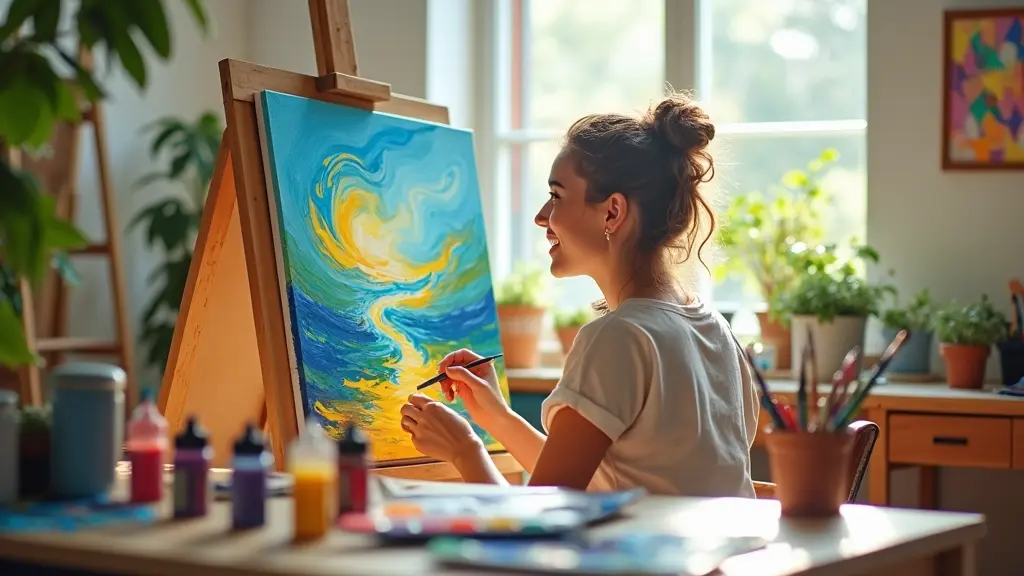
The gentle strokes of a palette knife apply acrylic paint to the canvas, summoning a kaleidoscope of colors that dance across the fabric. Few experiences evoke the same sense of liberation and self-expression as acrylic painting, allowing artists to tap into their imagination and creativity.
Acrylic Painting Techniques Spark Joy And Creativity
• Unleash your inner artist with acrylic painting techniques, a fun and creative outlet that sparks joy and self-expression.
• Discover how acrylic painting techniques can boost your mood, reduce stress, and increase confidence.
• Explore the versatility of acrylic painting techniques, from bold and vibrant strokes to delicate and intricate details. • Acrylic painting techniques are mastered by incorporating expressive brushstrokes, color blending, texture creation, layering, and canvas preparation, with a palette knife adding a unique twist to the final product.
Getting Started With Expressive Brushstrokes
Art has the power to evoke emotions, convey stories, and transport us to new dimensions. When we harness the expressive potential of brushstrokes, our art transforms into a symphony of movement, energy, and passion.
Getting Started With Expressive Brushstrokes
What are Expressive Brushstrokes?
Defining the concept
Expressive brushstrokes are a fundamental element of art that can elevate a piece from ordinary to extraordinary.
By using a combination of techniques, artists can create a unique visual language that communicates emotion, energy, and movement, achieved through the strategic application of wet-on-wet brushwork.
Understanding the benefits
Expressive brushstrokes offer numerous benefits, including the ability to convey a sense of spontaneity and emotional depth. This style of brushwork can also add texture and visual interest to a piece, making it a versatile and creative technique to master.

Mastering The Art Of Color Blending
Unlocking the power of art lies in the subtle alchemy of color blending, where the nuances of hue and tone come together to evoke emotions, convey meaning, and captivate the viewer’s attention. By embracing the art of color blending, artists can craft visually stunning pieces that resonate with audiences.
I.
Introduction.
Understanding the significance of color blending in art is crucial, as it allows artists to convey meaning, tell stories, and evoke emotions.
By mastering the art of color blending, artists can create visually stunning pieces that capture the viewer’s attention and leave a lasting impression.
II.
The Fundamentals of Color Blending.
Gesso-textured canvases provide the perfect foundation for experimenting with color theory, where hue, saturation, and value come together to create harmonious and effective color combinations. Brush selection plays a crucial role in successfully converting these fundamentals into a cohesive artwork.
How To Create Captivating Textures
Artistic expression is not just about visual representation, but about evoking emotions and sensations. By harnessing the power of texture, artists can transport viewers into a world of tactile experience.
Understanding Texture
Defining texture in art refers to the surface quality or feel of a piece, which can be achieved through various techniques.
Some common types of textures include rough, smooth, matte, and glossy, each adding a unique layer of dimensionality to the artwork.
Creating Texture with Acrylics
When working with acrylics, artists can achieve texture through impasto and layering techniques. By building up layers of paint, applying varying brushstrokes, and experimenting with mediums like varnishing, thinning paint to achieve desired consistencies, creating depth through overlapping and blending, capturing light and shadow to convey dimension, and employing perspective and gesture painting to add energy to the composition, artists can create a range of textures, from thick and chunky to smooth and blended, effectively drawing the viewer’s eye across the canvas.
Exploring Layering For Depth And Dimension
Painting is a journey of creative exploration, where every brushstroke holds the potential to reveal new layers of meaning and emotion.
Layering is a fundamental technique in acrylic painting that allows artists to build up complex, multi-dimensional images.
By carefully applying layers of paint, artists can create a sense of luminosity, texture, and visual interest that draws the viewer in.
I.
Introduction
Brief Overview of the Benefits of Layering
Layering is a timeless technique that has been woven into various artistic styles, from the bold, gestural brushstrokes of Abstract Expressionism to the intricate, photorealistic detail of Realism. In still life, layering can add depth and dimension to the arrangement of objects, while in portrait painting, it can create a sense of luminosity and presence. By focusing on the benefits of, artists can create captivating pieces in various styles, such as Abstract expressionism, Realism, Landscape, Still life, and Portrait, while applying principles of Color harmony.
Key Benefits of Layering in Acrylic Painting
- Layering allows artists to build up complex, multi-dimensional images.
- By applying layers of paint, artists can create a sense of luminosity, texture, and visual interest.
- Layering can add depth and dimension to still life arrangements and create a sense of luminosity and presence in portrait painting.
- Layering is a timeless technique that can be applied to various artistic styles, including Abstract Expressionism, Realism, Landscape, Still life, and Portrait.
Canvas Preparation Made Fun And Easy
The joy of creating art lies not just in the creative process, but also in the attention to detail that sets apart a masterpiece from a mediocre piece. By embracing the often-overlooked step of canvas preparation, artists can unlock a world of possibilities, yielding stunning results that leave a lasting impression.
Canvas Preparation Made Fun And Easy
### Why Canvas Preparation is a crucial step in the painting process
When it comes to crafting a masterpiece, every step counts.
Proper canvas preparation provides a solid foundation, allowing for better color retention, improved brushstrokes, and a more vibrant finish.
By investing time and effort into preparing your canvas, you’ll be rewarded with a professional-looking outcome that’s sure to impress. By being aware of these common mistakes, artists can create beautiful and professional-looking artworks on their canvases with confidence.
Unleashing Creativity With Palette Knife Techniques
Unlocking the Secrets of Unbridled Artistry. Finger painting with bold brushstrokes or applying color with a sponge-like texture can create a tactile experience that adds depth and emotion to a piece.
This obsession with exploring new techniques has led many to discover the transformative power of palette knife painting.
Introduction to Palette Knife Techniques
Context: Why Palette Knife Techniques are a Game-Changer for Acrylic Artists
Palette knife techniques have gained popularity in recent years due to their ability to add an extra layer of depth and dimension to acrylic paintings.
This versatility has made them a go-to choice for many artists looking to add an edge to their work. By incorporating finger painting, sponge application, scumbling, optical mixing, and atmospheric perspective, while considering tonal values, artists can create visually striking paintings that boldly showcase the benefits of palette knife techniques.
Unlocking the Secrets of Palette Knife Techniques
- Palette knife techniques have gained popularity in recent years due to their ability to add an extra layer of depth and dimension to acrylic paintings.
- By incorporating finger painting, sponge application, scumbling, optical mixing, and atmospheric perspective, artists can create visually striking paintings.
- The versatility of palette knife techniques has made them a go-to choice for many artists looking to add an edge to their work.
- Considering tonal values is crucial when using palette knife techniques to create paintings that boldly showcase their benefits.
Dry Brush Techniques For Unique Effects
The art world is constantly evolving, and one technique that has gained popularity in recent years is dry brushing, which allows artists to achieve unique effects and add depth to their work.
With the right tools and techniques, artists can achieve unique effects that elevate their work.
One such technique is dry brushing, which involves applying paint to a surface without the use of solvents or mediums.
As artists experiment with different Complementary colors, they often discover the versatility of dry brush techniques, which can create a range of Analogous schemes on a surface.
But what are dry brush techniques, exactly? In the simplest terms, dry brush techniques involve applying paint to a surface, usually canvas or paper, using a brush that has been loaded with paint. The paint is then spread across the surface by dragging the brush across it, rather than using a palette organization that prioritizes blending fingers to create a harmonious and balanced composition.
WetOnWet Painting: Tips And Tricks
When it comes to creating artwork with a sense of depth and dimensionality, few techniques rival the WetOnWet method. Studio setup is crucial, and with proper brush care, you’ll be well on your way to achieving a smooth, even blend.
Finishing Touches: Unlocking the Power of WetOnWet Painting
Mastery through practice and patience is key to unlocking the full potential of this technique.
With the right brush care, you’ll be able to achieve a smooth, even blend by allowing each layer to dry before adding more paint.
To get the most out of the WetOnWet method, it’s essential to understand the importance of a harmonious color palette. This can be achieved by experimenting with different brushstrokes and layering techniques to build texture and dimensionality.
WetOnWet Painting
- Mastery through practice and patience is key to unlocking the full potential of the WetOnWet method.
- Proper brush care is crucial for achieving a smooth, even blend in WetOnWet painting.
- A harmonious color palette is essential for building texture and dimensionality in WetOnWet artwork.
- Experimenting with different brushstrokes and layering techniques can help unlock the power of WetOnWet painting.
Watercolor Painting Projects Spark Joy And Creativity
Beginner Painting Ideas Spark Creativity And Joy
Beginner Painting Ideas Spark Creativity And Joy

As we navigate life’s complexities, a sense of stagnation can set in, leaving us yearning for creative expression and human connection. Brushstroke basics, in particular, have a profound impact on our emotional well-being, allowing us to tap into our inner world and channel our thoughts into something tangible.
Igniting Creativity
By embracing the world of art, individuals can discover a newfound sense of purpose and fulfillment.
Canvas exploration is a great way to begin, as it allows artists to experiment with various techniques and mediums, sparking a sense of excitement and curiosity. Beginner painting ideas are designed to be easy to follow, perfect for those looking to explore their creative side through canvas exploration, brushstroke basics, color theory, acrylic techniques, watercolor fundamentals, and easel setup.
Unleashing Creativity Through Canvas Exploration
The sense of liberation that comes with exploring the world of canvas art is unparalleled. When we let go of our inhibitions and dive into the creative process, we open ourselves up to a realm of self-expression and personal growth.
Shattering Artistic Barriers
Debunking common myths and misconceptions about art can be a major obstacle to creativity.
No one is born with a innate talent for art, and even the most skilled artists have to work hard to develop their skills.
To overcome self-doubt and fear of failure, remember that even the most renowned artists faced rejection and criticism at some point in their careers.
Techniques for Unlocking Creativity
Employing acrylic painting techniques like palette knife painting can add a new dimension of rugged texture creation to your artwork. Understanding still life composition and landscape essentials is crucial in creating visually appealing paintings.
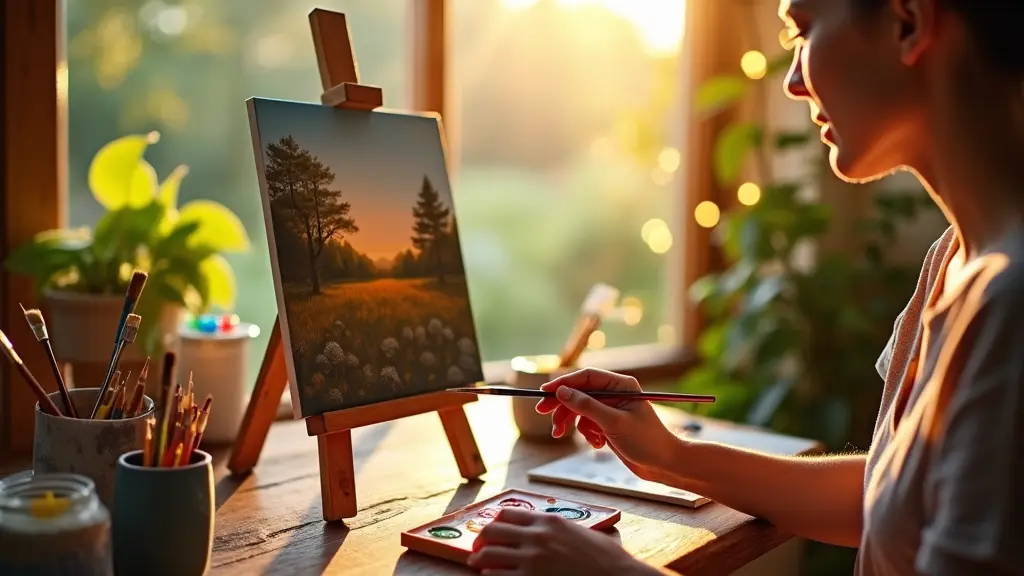
Brushstroke Basics For Beginners
Aspiring artists often overlook the power of brushstrokes, neglecting the fundamental technique that sets the stage for their masterpieces. In reality, understanding brushstrokes is the key to unlocking a world of artistic expression, allowing creatives to craft paints that not only capture their vision but also tell a story.
Brushstrokes are the foundation upon which artworks are built, and by mastering the basics, beginners can develop the skills to bring their ideas to life.
Understanding Brushstrokes for Beginners
Brushstrokes are the strokes of genius that make a painting come alive.
While seemingly simple, a single brushstroke can evoke emotions, convey moods, and add texture to an artwork. As beginners explore the world of brushstrokes, they’ll discover the importance of understanding stroke direction, pressure, and width to achieve professional-looking results in their art.
Understanding Brushstrokes for Beginners
- Brushstrokes can evoke emotions, convey moods, and add texture to an artwork.
- A single brushstroke can have a profound impact on the overall appearance and meaning of a painting.
- Mastering the basics of brushstrokes, including stroke direction, pressure, and width, is essential for achieving professional-looking results in art.
- Understanding brushstrokes allows creatives to craft paints that not only capture their vision but also tell a story.
Why Try Acrylic Techniques First?
Artistic inspiration beckons when stepping into the realm of acrylic painting, where the freedom to experiment with colors, textures, and techniques unlocks a world of creativity. Acrylic painting is perfect for art enthusiasts, offering an unparalleled level of flexibility and adaptability that makes it an ideal choice for beginners.
Getting Started: Unleash Your Creativity
Paint pouring with acrylic paint’s versatility and adaptability makes it a beginner-friendly medium, allowing them to learn basic techniques and build confidence.
Unlocking the Possibilities
Finger painting with different brushstrokes and textures creates unique effects, while sponge application and marbling effects add an extra layer of depth to your artwork. Building a Foundation in Acrylic Painting Mastering color theory and composition basics is essential for any acrylic painter, allowing artists to tap into artistic inspiration, creative exercises, paint pouring, finger painting, sponge application, and marbling effects to produce unique and captivating works of art.
Setting Up Your Artistic Workspace
As we strive for creative perfection, it’s easy to get bogged down by the chaos of our surroundings. Drip art is a delicate process that requires precision and patience.
A dedicated artistic workspace is essential for maintaining focus and productivity.
It allows artists to concentrate on their craft, uninterrupted by household chores or distractions.
To set up a functional workspace, consider the essentials you need to get started. This includes a stable table or desk, comfortable seating, and adequate lighting.
Visual stimulation is crucial for artistic growth – it can spark new ideas and inspire creativity. Stenciling is a great way to add a pop of color to your space and keep your inspiration flowing.
By optimizing your workspace, you can turn it into a haven that nourishes your creativity. Masking fluid is a clever technique that can help you achieve the perfect blend of colors and maintain the integrity of your design, even when working with techniques like drip art, stenciling, and dry brush.
Supporting Facts for Drip Art
- A dedicated artistic workspace is essential for maintaining focus and productivity.
- Visual stimulation is crucial for artistic growth and can spark new ideas and inspire creativity.
- Masking fluid is a clever technique that can help achieve the perfect blend of colors and maintain the integrity of your design.
- A stable table or desk, comfortable seating, and adequate lighting are the essentials needed to set up a functional workspace for drip art.
Mixing Hues For Vibrant Paintings
Artistic expression is often a delicate balance between contrast and harmony. When we combine colors thoughtfully, the result is a visually striking piece that draws the viewer’s attention and evokes an emotional response.
Mixing Hues For Vibrant Paintings
Introducing the Power of Hue Mixing: How Combining Colors Can Elevate Your Art
Mixing hues is an essential aspect of painting that can elevate your art from ordinary to extraordinary.
By applying impasto textures or using glazing techniques to combine colors in unique ways, you can create pieces that are emotionally impactful and truly memorable.
With the right tonal values, a painting can take on a life of its own, inviting the viewer to engage with the artwork. The color wheel is a fundamental tool for creating harmonious color schemes, whether using impasto, glazing, or tonal values, and for identifying complementary colors, negative space, and focal points.
What Inspires Beginner Painters?
As humans, we are wired to create and express ourselves through various forms of art, and painting is no exception. By diving into the world of colors and textures, beginner painters can unlock a sense of freedom and self-discovery.
Breaking Free from Fear
Busting the notion that I’m not artistic is a significant hurdle to overcome for many beginners.
By embracing the process over the outcome, painters can focus on the journey rather than the destination.
This mindset shift allows them to explore their personal experiences and emotions, uncovering a deeper sense of inspiration. As they begin to experiment with stippling, they’ll discover that their uniqueness shines through in the most beautiful ways.
Discovering Inner Creativity
Unleashing the power of imagination is a fundamental aspect of artistic expression. Exploring techniques such as gesture drawing, atmospheric perspective, scumbling, stippling, and wash application can help artists quickly block in shapes.
Texture Creation In Simple Steps
Unlocking the Power of Texture Creation in Art With every stroke of the brush, a world of emotions unfolds. Varnishing the surface, artists can unlock a tapestry of emotions, weaving stories that resonate with the soul.
Texture creation is a fundamental element in various art forms, allowing artists to convey emotions, tell stories, and add depth to their work.
By incorporating texture into their art, artists can elevate their creations from mere decoration to a rich and engaging experience.
I. Introduction
Brief overview of the importance of texture creation in art.
Artists have long recognized the significance of texture creation in framing a work of art.
Recognizing the emotional impact of texture on the viewer, artists use a range of techniques to create a sense of history, depth, and dimensionality.
**II. What is texture, then, but the culmination of artistic processes, including underpainting, priming surfaces, varnishing, framing, and art journaling, all brought together through expressive markmaking.
Expressive Markmaking For Novices
When we let go of inhibitions and allow ourselves to explore, the gates of creativity swing open, revealing a world of endless possibility. Expressive markmaking is a liberating technique that allows novice artists to break free from self-doubt and fears, unleashing their innate creativity.
According to zentangle experts, embracing imperfection is essential for growth and development as an artist.
By letting go of perfectionism, novices can focus on the process, rather than the product, and discover new techniques and mediums.
Intuitive painting styles, for instance, encourage artists to tap into their subconscious, allowing for a more authentic expression.
A key benefit of expressive markmaking is building confidence in one’s abilities.
By freely experimenting and exploring without judgment, novices can develop a sense of trust in their process and unlock their true creative potential. Found is a intuitive painting, zentangle, mandala creation, collage, mixed media, and found object art.
Expressive Markmaking
- Expressive markmaking allows novice artists to break free from self-doubt and fears, unleashing their innate creativity.
- Embracing imperfection is essential for growth and development as an artist, and letting go of perfectionism enables novices to focus on the process rather than the product.
- Intuitive painting styles, such as expressive markmaking, encourage artists to tap into their subconscious, allowing for a more authentic expression.
- Building confidence in one’s abilities is a key benefit of expressive markmaking, as freely experimenting and exploring without judgment can develop a sense of trust in the process and unlock true creative potential.
Personalized Paint Pouring Projects Bring Unforgettable Artistic Experiences
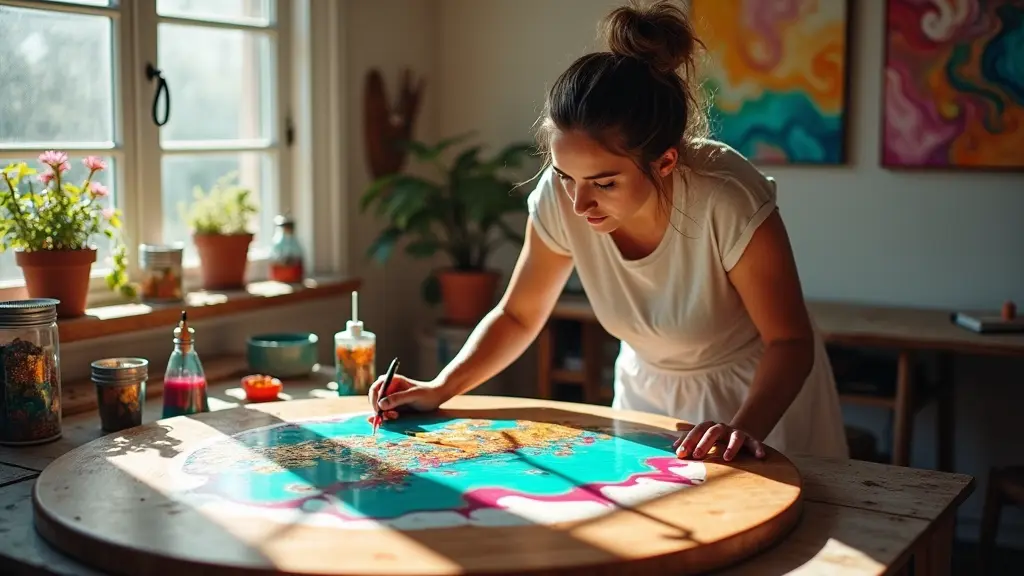
Discover the allure of creating a world of art that is uniquely yours, where the freedom to express yourself through vibrant colors and textures unfolds like a dream.
Imagine having the freedom to express your unique personality through art, crafting a one-of-a-kind masterpiece that reflects your style and emotions with precision and authenticity, fueled by artistic autonomy.
Witness the mesmerizing dance of colors as they swirl and blend, revealing a new and captivating art form that captivates and inspires, an artistic awareness that stems from the unbridled expression of your creativity.
Benefit from the expertise of skilled artists who will guide you through the process, ensuring your masterpiece is a reflection of your individuality and artistic voice, expertly crafted with artistic craftsmanship.
How to Create Artistic Adventures
As we dive into the world of art, it’s easy to get lost in the endless possibilities and forget the importance of having a clear vision. In reality, the most impactful artistic creations begin with a well-thought-out plan, a willingness to take risks, and a commitment to continuous growth.
Preparation is Key
When embarking on an artistic adventure, it’s essential to break free from creative constraints and allow for unexpected outcomes and serendipitous discoveries.
Developing a growth mindset and being open to feedback and improvement is crucial to refine your artistic expertise.
Embracing Experimentation and Risk-Taking
Exploring different sources of inspiration, from nature to art and music, can fuel your artistic exploration and help you discover new techniques. Establishing a consistent practice routine can cultivate motivation and sustain your creative momentum, allowing you to achieve Artistic Excellence, where your skills and artistry reach their full potential.
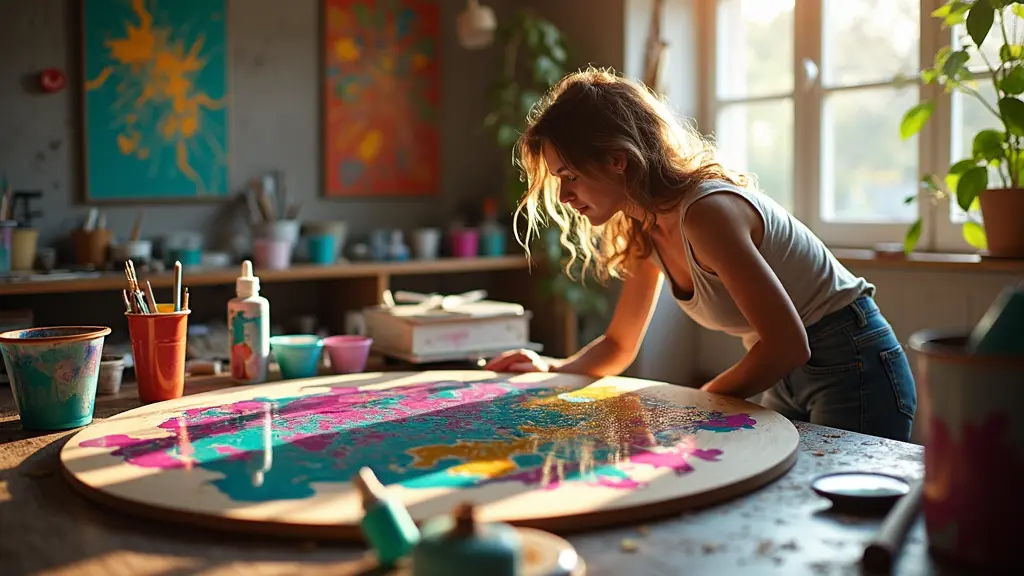
Is Paint Pouring a Fun DIY Project
The Joy of Unleashing Creativity In today’s fast-paced world, it’s easy to get stuck in a rut and lose touch with our creative sides. But what if we told you that there’s a simple and fun way to revive your artistic soul? Enter paint pouring, a captivating DIY project that has taken the world by storm.
With the rise of DIY and handmade projects in recent years, paint pouring has become a popular activity for those seeking creative expression and relaxation.
This unique form of abstract art allows individuals to tap into their artistic feelings, unleashing a world of possibilities and artistic freedom.
Paint pouring is not just a creative outlet, but also a therapeutic activity that has been shown to reduce stress and anxiety, promoting a sense of calm and well-being. The artistic fun begins with the unique techniques involved in paint pouring, where combining different colors, textures, and emotional expressions of Artistic Feelings, Artistic Freedom, Artistic Growth, and Artistic Imagination, all fuelled by Artistic Inspiration.
Paint Pouring
- Paint pouring has become a popular DIY project in recent years, with many individuals seeking creative expression and relaxation.
- Paint pouring has been shown to reduce stress and anxiety, promoting a sense of calm and well-being.
- The unique techniques involved in paint pouring allow individuals to combine different colors, textures, and emotional expressions, unleashing a world of artistic possibilities.
- Paint pouring is not just a creative outlet, but also a therapeutic activity that can be enjoyed by people of all ages and skill levels.
Unlocking Artistic Expression
The human experience is a rich tapestry of emotions, thoughts, and experiences that yearn to be expressed. When we tap into our creative potential, we unlock a realm of self-expression and personal growth, guided by artistic intensity.
The pressures and constraints on creative expression are often overwhelming, leading many to suppress their artistic side.
The importance of exploring one’s artistic side cannot be overstated.
As we venture into the world of artistic expression, we discover a realm of artistic liberty where our unique perspectives and styles can flourish.
The psychology of artistic expression plays a crucial role in our mental well-being.
Creativity serves as a powerful stress relief, while self-esteem and confidence soar with artistic fulfillment, making mental health a significant benefit of unlocking artistic expression. fostering a sense of creative fulfillment.
What Makes Painted Creations Unique?
Personalized art has the power to evoke emotions, tell stories, and capture moments in time. When done with finesse and precision, it can become a treasured family heirloom or a symbol of one’s unique artistic mood.
Understanding the Art of Personalized Creations
Painted Creations is a renowned art studio that has mastered the art of artistic originality.
Exploring the world of custom art, the studio has established itself as a leader in the industry.
Artistic passion is evident in every brushstroke, precision guide, and stroke of artistic proficiency that brings clients’ visions to life. Facts about the art of customization reveal that every piece is a one-of-a-kind masterpiece, created with a deep understanding of artistic personality.
Personalized Art
- Personalized art can evoke strong emotions and create a sense of connection with the viewer.
- Custom art pieces are unique and one-of-a-kind, making them treasured family heirlooms or symbols of personal artistic expression.
- Artistic passion and precision guide the creation of each custom art piece, bringing the client’s vision to life.
- Every custom art piece is a masterpiece, created with a deep understanding of artistic personality and a focus on originality.
From Abstract Art to Personalized Masterpieces
The ever-changing landscape of artistic expression has given rise to a plethora of artistic qualities, with each brush stroke and color palette choice speaking to an individual’s unique artistic taste. The evolution of art has been marked by a series of bold experiments, each pushing the boundaries of what is possible.
With the advent of modern technology, artists are now able to create masterpieces that are not only breathtakingly beautiful but also infused with a sense of rarity and exclusivity.
From intricate digital art to handcrafted sculptures, the possibilities are endless, allowing artists to tap into their innermost reflections and bring forth works that are truly reflective of their artistic style.
The ability to create personalized masterpieces has opened up new avenues for artistic expression, enabling individuals to leave their mark on the art world like never before. Whether it’s a unique painting, a custom-designed sculpture, or a one-of-a-kind piece that embodies Artistic Quality, Artistic Rarity, Artistic Reflection, Artistic Skill, and Artistic Style, reflecting the buyer’s distinctive Artistic Taste.
How Do I Get Started with Paint Pouring?
Exploring the world of paint pouring allows you to tap into your artistic brushstrokes, unleashing a colorful explosion of creativity and self-expression. Painting is a timeless form of art that enables individuals to convey their colorful emotions and thoughts, and with paint pouring, you can create unique, one-of-a-kind masterpieces that reflect your personality.
I.
Introduction
Paint pouring is a popular art form that has gained worldwide recognition for its mesmerizing, swirling patterns and vibrant colors.
By combining different paints, mediums, and techniques, you can create a wide range of effects, from delicate, lace-like patterns to bold, textured masterpieces. Whether you’re a seasoned artist or a beginner, paint pouring is an excellent way to express yourself and tap into your creative potential.
**II. Preparing for Your Colorful Masterpieces that are born from Artistic Uniqueness, Brushstrokes, Color Palette, and Colorful Emotions that bring Colorful Moments to life.
Paint Pouring
- Paint pouring is a popular art form that has gained worldwide recognition for its mesmerizing, swirling patterns and vibrant colors.
- By combining different paints, mediums, and techniques, you can create a wide range of effects, from delicate, lace-like patterns to bold, textured masterpieces.
- Paint pouring is an excellent way to express yourself and tap into your creative potential, regardless of your level of artistic experience.
- Paint pouring masterpieces are unique and one-of-a-kind, reflecting the personality and emotions of the artist who created them.
Bringing Colorful Emotions to Life
Unlocking the Power of Colors and Emotions Did you know that our brains process visual information 60,000 times faster than text-based information? As a result, we’re wired to respond emotionally to colors, making them a potent tool for connecting with our subconscious mind and evoking powerful feelings.
Exploring the Art of Artistic Autonomy
As we stroll through joyful moments of creative solitude, we often stumble upon hidden reservoirs of inspiration, waiting to be tapped. Amidst the ebb and flow of everyday life, we begin to yearn for a sense of liberation, a freedom to express ourselves unapologetically.
Breaking Free from Constricting Influences
As artists, we often find ourselves influenced by external pressures and expectations.
By shedding these constraints, we can unleash a torrent of innovative ideas and tap into our true potential.
Mixed Media techniques, with their unique blend of textures and colors, provide a perfect canvas for our artistic autonomy to flourish, leading to groundbreaking creations. Embracing imperfection and uncertainty is a celebration of life’s joyful moments through Mixed Media, Mixed Media Art, Painted Creations, Paint Pouring, and Painting Techniques.
Paint Pouring Tips Master the Art of Unleashing Your Creativity
Paint Pouring Tips Master the Art of Unleashing Your Creativity
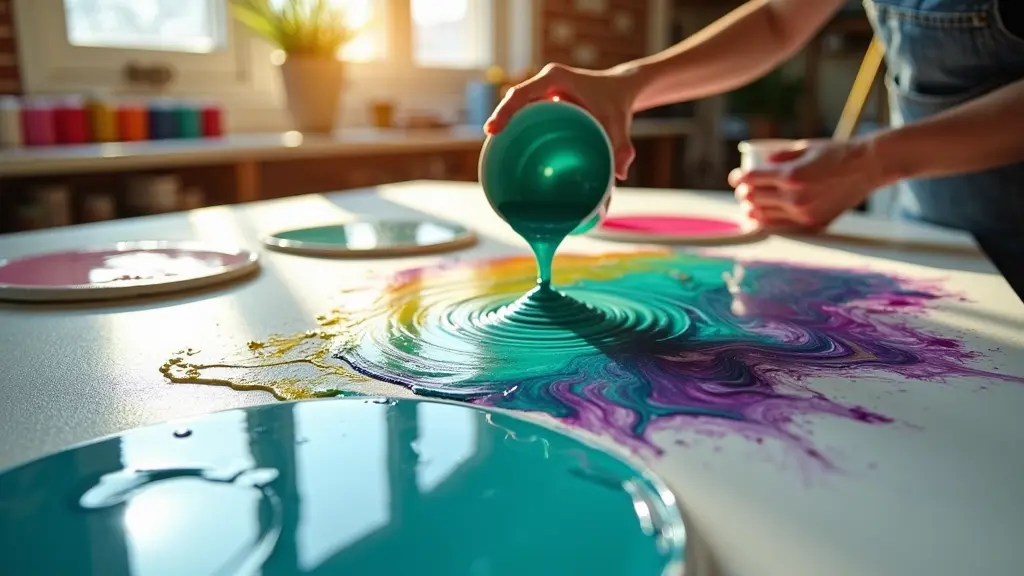
In the world of art, there’s something profoundly enjoyable about witnessing a blank canvas transform into a vibrant, abstract masterpiece. When we create, we’re not just crafting something with our hands, but also pouring our thoughts, emotions, and experiences into the work.
Affordable and accessible, paint pouring is a unique modern technique that allows individuals to unleash their creativity and transform blank canvases into stunning works of art.
The art of paint pouring offers endless possibilities for artistic expression.
By experimenting with bold brushstrokes, unique color combinations, and subtle texture plays, artists can tap into their artistic vision and style, unlocking a world of creative freedom. One of the key benefits of paint pouring is its ability to help individuals develop their abstract art, unique artistic expressions, and distinctive artistic style and vision through bold, expressive brushwork.
Can I Pour Paint
Unlocking the World of Spontaneous Artistry.
Artistic Expression Unleashed with Paint Pouring
Paint pouring has become a modern art phenomenon, captivating artists and non-artists alike with its unique visual aesthetic and therapeutic benefits.
This innovative technique allows individuals to tap into their creative potential, fostering a sense of calm and fulfillment.
The Science of Paint Pouring
Mixing color combinations is not just about blending hues, but also understanding the chemistry behind the materials.
Paint pouring relies on the principle of fluid dynamics, where the viscosity and density of the paint determine the final design.
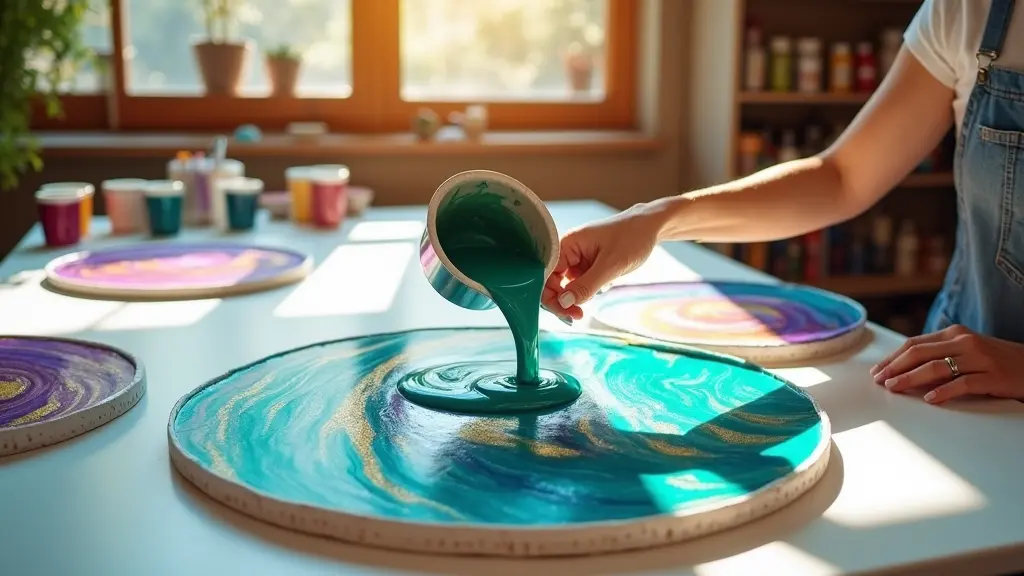
Colorful Expressions
Unleashing Creativity Through Color In a world where visual stimuli play a significant role in shaping our perspectives, colorful expressions have emerged as a potent catalyst for unleashing creativity. By exploring the intricate relationships between hues, we can tap into the hidden dimensions of our imagination, giving rise to innovative and artistic forms of self-expression.
Colors have the power to evoke emotions and influence our mood, which is why it’s essential to understand the science behind colorful expressions.
The Science Behind Colorful Expressions
Colors aren’t just visually appealing; they also have a profound impact on our emotional responses.
Studies have shown that the colors we surround ourselves with can affect our mood, energy levels, and overall well-being. For instance, a study by the American Society of Interior Designers found that people who worked in rooms with natural light and warm colors (such as orange and yellow) experienced increased creative freedom and were more productive.
Freeing Your Brushstrokes
When you let go of expectation and simply allow yourself to create, you’re surprised by the depth and richness that emerges from the canvas.
Connecting with your creative self allows you to tap into a deeper sense of purpose and meaning.
Overcoming self-doubt and fear of imperfection enables you to unleash spontaneity and freedom in art-making.
II.
The Power of Unbridled Expression
Expressive art can be a powerful medium for exploring the depths of human emotion, embracing the beauty of uncertainty and surprise. This approach allows you to express your emotions honestly and authentically, dripping with passion and fluid motion.
III. Liberating Your Artistic Voice
Developing trust and confidence in your creative process is crucial to letting go of perfectionism and embracing the imperfect beauty of drippy colors and freeform art. Understanding the importance of embracing creativity, I discovered a new appreciation for drippy art, drippy colors, expressive art, fluid art, fluid motion, and freeform art.
How to Blend Colors
Incorporating color blending techniques into your artistic repertoire can unlock a world of creative possibilities, from subtle nuances to striking contrasts. By embracing innovative methods, artists can elevate their work from mere representations to rich, immersive experiences.
Introduction to Color Theory
————————-
Understanding the color wheel and its importance in art is crucial for mastering the art of color blending.
The color wheel is a circular representation of colors, with primary colors at the center, secondary colors created by mixing two primary colors, and tertiary colors formed by combining primary and secondary colors, allowing for freehand painting techniques to flourish.
Why Blending Colors Matters
—————————
Color blending is not just a matter of mixing colors together; it’s an art form that can enhance mood and atmosphere in art, create depth and dimensionality, and break away from traditional color schemes. By experimenting with different freehand painting, glazed finishes, homemade paint, innovative methods, layering effects, and liquid art.
Key Points About Color Blending
- The color wheel is a circular representation of colors, with primary colors at the center, secondary colors created by mixing two primary colors, and tertiary colors formed by combining primary and secondary colors.
- Color blending can enhance mood and atmosphere in art, create depth and dimensionality, and break away from traditional color schemes.
- Freehand painting techniques, glazed finishes, homemade paint, innovative methods, layering effects, and liquid art can be used to experiment with color blending.
- Elevating artistic work from mere representations to rich, immersive experiences is possible by embracing innovative color blending methods.
Pouring Artistic Vision
The human desire to create and express oneself is a vital aspect of our existence. It is this creative drive that allows us to tap into our emotions, thoughts, and experiences, giving rise to works of art that are a reflection of our unique perspectives.
Pouring Artistic Vision
Artistic vision is the ability to see beyond the ordinary and infuse our creations with our unique perspective.
This concept is especially relevant in the mixed media art world, where the fusion of colors, textures, and emotions comes together to create something truly multidimensional.
By embracing this artistic vision, we can unlock a world of possibilities and bring our innermost thoughts and feelings to life.
Pour painting’s origins date back to the 1950s, when artists began experimenting with unconventional paint application techniques to create dynamic, experimental pieces. Over the years, the art form has evolved to incorporate a unique blend of mixed media, mixed media art, multidimensional art, paint application, paint blending, and paint dripping techniques.
The Joy of Drippy Art
The mesmerizing allure of unconventional art has captivated audiences worldwide, and its unique appeal lies in the unpredictable and captivating visual effects it yields. By combining bold colors and textures, artists can create a dynamic and captivating display that resonates with viewers on a deeper level.
The Concept and History of Drippy Art
Drippy art, also known as pour painting, has its roots in the 1960s and 1970s when artists began experimenting with fluid paint pouring techniques.
By pouring paint onto a surface, artists can create intricate patterns, dynamic textures, and vibrant colors, allowing for a more free-flowing and spontaneous creative process. allows for unparalleled creative expression and customization.
Drippy Art
- Drippy art, also known as pour painting, has its roots in the 1960s and 1970s.
- By pouring paint onto a surface, artists can create intricate patterns, dynamic textures, and vibrant colors.
- The use of fluid paint pouring techniques allows for a more free-flowing and spontaneous creative process.
- This technique allows for unparalleled creative expression and customization.
The Magic of Fluid Art
A Journey Through The Magic of Fluid Art Research has shown that engaging in fluid art activities can significantly boost cognitive function, particularly in areas such as problem-solving and memory retention, by exploiting the dynamic interplay between creativity and pour painting techniques.
The Magic of Fluid Art: Unleashing Creativity
• Discussing the cognitive benefits of fluid art, a study published in the Journal of Cognitive Psychology revealed that creating resin art increased blood flow to the brain, leading to improved focus and concentration.
Strong emotions are a fundamental aspect of the human experience, and fluid art provides an outlet for expressing and processing them, utilizing pouring medium as a medium for emotional expression. Examining the therapeutic benefits of fluid art, a study by the American Art Therapy Association discovered that engaging with resin applications reduced symptoms of anxiety and depression in individuals by promoting relaxation, leading to a newfound sense of calm and serenity.
Visualizing Creative Freedom
The thrill of creating something entirely new and original can be daunting, as the blank canvas stares back at us with an endless array of possibilities. Visualizing creative freedom can be a powerful tool for breaking free from these shackles.
Breaking Free from Creative Constraints
By tapping into the power of visualization, artists can uncover a sense of liberation from self-doubt and criticism, working with semitransparent layers of confidence that allow every stroke of the brush to bring a new level of clarity to their art.
Imagine the freedom to explore and experiment without fear of failure, unencumbered by the nagging voices of doubt and fear. Unlocking Imagination and Inspiration**
Visualizing creative freedom can spark a torrent of new ideas and foster innovative thinking, allowing artists to develop unique artistic styles and expressions that blend and merge in unexpected ways, much like the intertwining of semitransparent layers, splattered art, textured art, and transparent blends, resulting in a kaleidoscope of texture and color.
| Visualization Techniques | Benefits | Challenges | Results |
|---|---|---|---|
| Free Association | Increases creative freedom | Can lead to mental exhaustion | Unlocks new ideas and perspectives |
| Mind Mapping | Fosters innovative thinking | Can be overwhelming for beginners | Helps organize and connect ideas |
| Stream-of-Consciousness Writing | Breaks down creative barriers | Can be difficult to edit | Unleashes a torrent of new ideas |
Personalized Paint Pouring Projects Bring Unforgettable Artistic Experiences
Paint Pouring Community Celebrates Creative Freedom
Paint Pouring Community Celebrates Creative Freedom

Embracing unstructured art allows individuals to tap into their deepest emotions and bring forth vibrant colors that resonate with the human experience.
In this liberating process, artists surrender to the flow of creativity, resulting in emotional expressions that defy the boundaries of traditional art forms.
As a creative exploration, paint pouring fosters a sense of community, encouraging artists to share their unique experiences, learn from one another, and push the limits of their artistic abilities.
is a haven for artistic expression where creativity knows no bounds.
Creative Exploration
As we surrender to the freedom of creative expression, we find ourselves swept away by a wave of mindful moments, lost in the joy of spontaneous art.
Unlocking the Power of Imagination
Boosting Mental Health
Creative exploration has been shown to have a profound impact on our mental wellbeing, reducing stress and anxiety while promoting a sense of calm and well-being.
The Science Behind Creativity
Neuroplasticity and Brain Rewiring
When we engage in creative activities, our brains undergo significant changes, rewiring neural connections and increasing dopamine release, leading to improved mood and cognitive function.
The Benefits of Creative Exploration in Everyday Life
Increased Productivity
By incorporating creative activities into our daily routine, we can improve our problem-solving skills, allowing us to tackle challenges with renewed fluid techniques, and discover new joy in the journey
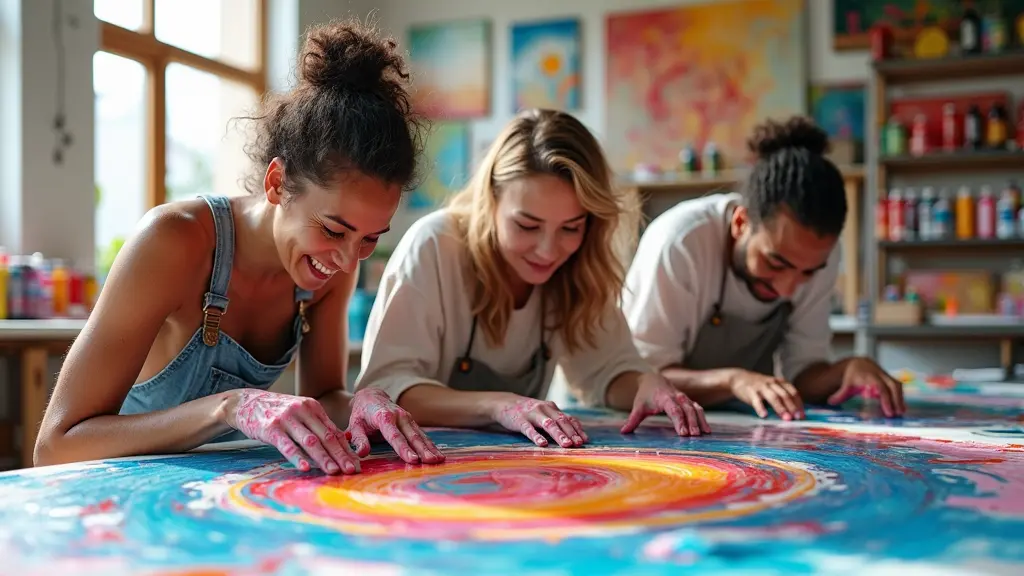
What is Paint Pouring?
Painting has the power to transform our lives, providing a refreshing escape from the chaos of daily routines and allowing us to tap into our creative potential. As we navigate the complexities of modern life, it’s easy to lose touch with our artistic selves, but embracing Colorful Experiences can have a profound impact on our emotional well-being, fostering a sense of calm and tranquility.
What is Paint Pouring?
Paint pouring is a unique and dynamic form of artistic expression that involves pouring paint onto a surface, allowing it to flow and merge in unexpected ways.
This technique has its roots in abstract expressionism, dating back to the 1950s when artists began experimenting with dripping and pouring paint onto canvases. At its core, paint pouring is a process that requires patience, mindfulness, and a willingness to let go of control, ultimately resulting in a kaleidoscope of Colorful Experiences, Art Therapy Benefits, Handmade Masterpieces, and Artful Expression.
Paint Pouring
- Paint pouring has its roots in abstract expressionism, dating back to the 1950s.
- This technique requires patience, mindfulness, and a willingness to let go of control.
- Paint pouring can result in a kaleidoscope of Colorful Experiences, Art Therapy Benefits, Handmade Masterpieces, and Artful Expression.
- Paint pouring is a unique and dynamic form of artistic expression that involves pouring paint onto a surface, allowing it to flow and merge in unexpected ways.
Emotional Expression Through Color
Colors have the extraordinary ability to tap into our emotions, allowing us to convey complex feelings and moods with remarkable ease. This phenomenon is rooted in the unique connection our brains have with color, which enables us to associate certain hues with specific emotions and memories.
Understanding the history of color theory is crucial in appreciating the impact of color on art.
From the pioneering works of Isaac Newton to the contemporary findings in the field of cognitive psychology, the science behind color perception and emotions has been extensively studied.
For instance, the use of warm colors in ancient cultures signified power and energy, while cool colors conveyed calmness and serenity. This fundamental understanding of color’s emotional significance has been leveraged by artists across genres and mediums, yielding a diverse range of expressive and emotive works. When it comes to Relaxation through Art, color plays a vital role in Dynamic Creations, Flowing Art, and Expressive Freedom.
How to Start
Embracing the realm of Artful Adventures can be a life-enriching experience, fostering a sense of creative expression and self-discovery. By undertaking this artistic journey, individuals can unlock their unique voice and style, leading to a deeper understanding of themselves and the world around them.
Before delving into the world of paint pouring, it’s crucial to grasp the fundamentals.
Paint pouring is a form of abstract art that involves pouring and manipulating paint onto a surface to create unique, expressive pieces.
Recognizing the significance of creativity and self-expression in art can lay the groundwork for a successful artistic venture.
Assembling the right materials is vital for beginners.
Ensure you have the necessary supplies, including high-quality paints, durable surfaces, and effective tools. Prioritizing quality and durability will significantly impact the overall effectiveness of artistic pursuits, color theory applications, art therapy sessions, and artful adventures.
Unstructured Art Journey
The pursuit of creativity has long been a vital part of human expression, and yet, many of us may find ourselves stuck in a rut, feeling constrained by traditional norms and expectations. Mindfulness through Painting
| Unstructured Art Journey | |||||||||||||||||||||||||||||||||||||||||
|---|---|---|---|---|---|---|---|---|---|---|---|---|---|---|---|---|---|---|---|---|---|---|---|---|---|---|---|---|---|---|---|---|---|---|---|---|---|---|---|---|---|
| 1 | Freedom in Creation | ||||||||||||||||||||||||||||||||||||||||
| •
Unstructured art offers a liberated space for artists to explore their thoughts, emotions, and experiences without the burdens of conventional approaches. By embracing the unknown, we can unlock a sense of freedom and autonomy in the creative process, allowing us to unwind with art and savor joyful moments of playful exploration. Flowing Art TechniquesAs we navigate the world of art, many of us are drawn to the precision and control that comes with technique-driven art forms. There’s a quiet rebellion brewing among artists who crave the thrill of the unknown, the excitement of spontaneity, and the liberation that comes with letting go of perfection. This ancient art form has its roots in various cultures, with evidence of flowing art dating back to ancient civilizations such as Egypt and China. Principally, flowing art relies on the harmonious blend of colors, allowing artists to create unique and captivating effects. The unpredictability of flowing art also makes it an exciting medium for artists, as it requires a level of adaptability and creativity to capture the desired outcome. Principles of fluid dynamics play a crucial role in the blending of colors, allowing artists to create unique and captivating artistic masterpieces through their creative journey.
Mindful Moments with ColorsIn the midst of a chaotic world, it’s surprising how a brush stroke of color can bring instant calmness. Here, we’ll explore the world of colors as a tool for mindfulness, a perfect blend of artful play and self-discovery. Mindful Moments with Colors offers a unique and powerful solution to achieve a sense of relaxation and inner peace. By incorporating mindfulness techniques with color exploration, individuals can experience a profound sense of calmness and serenity. I. Introduction Regular mindfulness practice has been shown to reduce symptoms of anxiety and depression, improve sleep quality, and even boost the immune system. When combined with the calming effects of colors, the benefits of mindfulness can result in a profound sense of relaxation and inner peace. Joyful Creation ProcessAs we embark on a creative adventure, our minds expand with endless possibilities, and our spirits lift with the thrill of discovery. When we surrender to the joy of making, we tap into a sense of fulfillment that resonates deeply within. Embracing the Present Moment One of the most significant benefits of this Colorful Art process is its ability to help us let go of perfectionism and fully immerse ourselves in the present moment. When we focus on the journey rather than the outcome, we experience a greater sense of calm and contentment. This mindfulness allows us to fully engage with the creative process, unlocking our potential and leading to a more fulfilling experience. Unlocking Creative Potential The Art Therapy Process is not limited to painting alone. It’s a great way to unwind and express yourself creatively. Creative Art
Paint Pouring Tips Master the Art of Unleashing Your Creativity Paint Pouring Techniques for Beginners Discover the Joy of Creative Expression
As we navigate the world of modern art, it’s easy to get caught up in the intricacies of technique and perfection. But what if I told you that there’s a way to unleash your creativity, free from the constraints of traditional methods? The fluid motion of pouring paint creates unique and stunning artworks that can be customized to suit individual tastes. Getting Started with Paint Pouring Techniques Experiment with different brushwork techniques to achieve your desired outcome. Color blending is a vital aspect of Abstract Artistic expressions, allowing the painter to effectively combine Colors with Brushwork and Cellulose techniques, culminating in a harmonious balance of Creative Expression and Freedom of Fluid Drip. How to Start Painting JourneyStarting a new creative journey can be a liberating experience, filled with joy and luminous possibilities. Setting the Foundation: Understanding the Basics of Painting This includes grasping color theory, composition, and diverse brushstrokes to confidently execute your artistic vision. Preparing Your Space: Essential Supplies and Equipment This includes a comfortable workspace, a variety of paints, brushes, and surfaces to unleash your multicolored imagination. Choosing Your Color Palette: Exploring Different Color Schemes Experiment with various color schemes to discover what sparks your innovative spirit and brings your artistic vision to life. Mastering the art of HandPainted Multicolored Geometric designs brings joyful Fun and a sense of Impromptu Innovation, illuminating the process with Luminous Movement.
What is Pouring Medium?In recent years, the art world has witnessed a surge in innovative approaches to creative expression. Among these, pouring medium has emerged as a standout medium that has captured the attention of artists globally. This Newbie-friendly material has transformed the way artists work with paint, offering a NonTraditional way to produce textured, three-dimensional pieces. Definition and Origin Its unique composition allows for exceptional blending and layering capabilities, making it an ideal choice for artists seeking to create textured, three-dimensional pieces. Composition and Properties
Freedom in Brushwork Mixing ColorsThe world of art is a canvas of endless possibilities, and yet, many artists struggle to break free from traditional technique. By embracing swirling brushstrokes and spontaneous color combinations, you can unlock a world of creative expression and unleash your artistic potential. I. Freedom in Brushwork Mixing Colors By mixing colors, we can create a wide range of hues and shades, but often, our brushstrokes are restricted, limiting the potential of our art. II. Understanding the Importance of Brushwork Control Spontaneous Art ExpressionLife’s monotony can be interrupted by a splash of vibrant color, a burst of creative energy, or a moment of unbridled self-expression. Unique art forms have the power to break free from convention, allowing us to tap into our inner selves and rediscover our sense of purpose. Spontaneous art expression is more than just a fun activity – it has a profound impact on our mental and emotional well-being. By embracing our creative sides, we can experience a significant reduction in stress and anxiety levels, as our minds focus on the present moment and the joy of creation. Boosting our creativity and imagination is another key benefit of spontaneous art expression. As we experiment with different mediums and techniques, our minds stay active and engaged, fostering a sense of self-discovery through the unconventional, unique, unpredictable, and unstructured water-based acrylic visual art process of WetonWet, then WipeOff, to reveal a distinctive Work of Art. Benefits of Spontaneous Art Expression
Does it Require TechniqueAs we embark on the creative journey of paint pouring, it’s essential to acknowledge the significance of artistic expression in shaping our masterpieces. this art form has captured the hearts of many, allowing individuals to tap into their imagination and produce unique, one-of-a-kind creations that reflect their personality and style. Understanding the Fundamentals To unlock the full potential of paint pouring, a solid foundation of technique is crucial. Color theory, layering, and blending are key components that, when mastered, can elevate our creations to new heights. By understanding how to mix colors effectively and combining different hues, we can create harmonious palettes that resonate with our artistic vision. vibrant and dynamic artwork that showcases your artistic expression. Unconventional Art Forms Create TextureUnconventional Art Forms Create Texture Few experiences in life can rival the joy of being surrounded by Free Spirited art that celebrates the beauty of imperfection. As we journey through the world of art, we’re often confronted with traditional forms that, while magnificent in their own right, can feel limiting and predictable. By embracing the unconventional, we open ourselves up to a world of creative possibilities. I. Introduction But for many artists, working within these boundaries can become stale and uninspiring. This is where unconventional art forms come in – offering a chance to break free from conventional norms and express oneself in a more authentic way. **II. The benefits of uncontrolled, free-spirited, fun and easy art, characterized by the use of geometric shapes, handcrafted techniques, and improvisation, are a joyful experience, as each piece is a unique blend of innovative art, layering, and liquid art mixed media techniques. Unconventional Art Forms
Painting Techniques for BeginnersThe Art of Expression Many people who have never ventured into the world of art assume that creating something beautiful is reserved for the gifted few. Yet, the truth is, painting can be a journey that anyone can embark upon, regardless of skill level or experience. Painting is a journey that allows you to slow down, relax, and connect with your creative side, fostering a sense of Movement in Art that can be both calming and invigorating. By mastering the basics, you’ll be able to express yourself in a way that’s both therapeutic and fulfilling, unlocking a world of Multicolored Art that’s uniquely yours. As you begin this artistic journey, you may be surprised by the numerous benefits that come with mastering the basics of painting. Not only will you discover a new creative outlet, but you’ll also experience a sensual experience of pouring colors and manipulating shape and form. Pouring Colors with JoyThe thrill of discovering hidden patterns and textures through an art form that defies precision reignites our sense of adventure and freedom. As we delve into the world of pouring colors, we discover a realm where Swirling Colors blend together to create mesmerizing patterns and textures. By combining Strokes and Brushwork with a dash of unpredictability, we can create unique pieces of art that showcase our personal Style and Technique. The joy of pouring colors lies not only in the final product, but in the process itself, where we can let go of our inhibitions and allow our creativity to flow freely, generating Timed Art that reveals the beauty of the moment. As we explore the world of pouring colors, we’ll experience the liberation that comes with embracing Unpredictable Art, where the outcome is as much a celebration of Spontaneous Creation, Strokes and Brushwork, Style and Technique, Swirling Colors, Texture and Dimension, ThreeDimensional Art, Timed Art, ToolFree Art, Unique Art, and Timed Art.
Paint Pouring Community Celebrates Creative Freedom DIY Paint Pouring Gifts Bring Joy to Your Loved Ones
The sensation of creative fulfillment can be hard to beat, but sharing that feeling with others can amplify the joy exponentially. By embracing DIY paint pouring, you can unleash your creative flair and bring joy to your loved ones with personalized, one-of-a-kind masterpieces. These artistic expressions evoke emotions and create lasting memories. Gift-givers can involve themselves in the process, fostering bonding and a sense of accomplishment with every brushstroke on canvas. Unique pieces are crafted with attention to detail, showcasing the recipient’s interests and personality with every splash of abstract awesomeness. Every DIY Paint Pouring Gift absorbs the essence of its creator, making it a treasured possession that reflects the giver’s thoughtfulness and care. With a bold and abstract style, the artist’s brushwork brought awesomeness to the canvas. How to Pour Paint Creatively I am not sure what you mean. Introduction** This unique technique allows artists to tap into their imagination and bring forth stunning, abstract creations that exude a sense of playful creativity and joyful coloration. II. Understanding the Basics Understanding the concept of fluid art and its unique characteristics will help you achieve the desired effects. III. Tips and Tricks for Success Experimenting with different techniques, such as layering and texture creation, will enhance your creative designs. A perfect blend of drippy textures and vibrant colors can result in a truly captivating creative design.
Can Paint Pouring Be TherapeuticArt has long been a source of solace and self-expression, offering a healthy escape from the stresses of everyday life. By embracing the unconventional art form of paint pouring, we can tap into its numerous mental and emotional benefits. Paint pouring, also known as fluid art, has recently gained immense popularity for its mesmerizing visual effects. This process involves pouring paint onto a surface, allowing it to flow and merge in unique and imaginative ways. As a form of self-expression, paint pouring enables individuals to tap into their creative side, fostering a sense of fun and relaxation. The Therapeutic Benefits of Paint Pouring
Unlocking Awesomeness through BrushworkLife’s creative wellspring lies dormant, waiting for the catalyst to awaken our inner artist. Inspirational brushstrokes can unlock a kinetic sense of freedom, as hesitations give way to innovative expressions of self. When we tap into our artistic side, we tap into a joyful dimension where self-doubt and fear dissolve, leaving us empowered and liberated. Brushwork offers a unique opportunity to distill the complexities of life into simple, layered strokes, allowing us to peel back the layers of our minds and emotions. As we focus on the benefits of embracing this creative outlet, we discover that it’s not just about producing aesthetically pleasing art – it’s about cultivating a sense of inner peace and confidence. Through brushwork, we can access a world of self-expression, unencumbered by convention, yet empowered by the inspirational, innovative, joyful, and kinetic possibilities that layer themselves in a rich and meaningful way. What Makes Paint Pouring Gifts Unique?Gift-giving has evolved, and the modern era demands more from our presents. Gone are the days of impersonal, mass-produced items that lack a personal touch. We crave uniqueness, emotion, and a tangible connection to the giver. What Makes Paint Pouring Gifts Unique? With their mesmerizing swirls of color and unique textures, they are truly a work of modern art. Paint pouring is a deeply personal and emotive art form that allows the creator to express their innermost feelings and emotions. By pouring and manipulating liquid paint onto a surface, the artist can create a stunning masterpiece that is truly one-of-a-kind. There’s something undeniably special about holding a handmade gift that has been crafted with love and care, like a liquid masterpiece that’s mesmerizing in its modern, movable beauty. What Makes Paint Pouring Gifts Unique?
Should You Use Modern ColorsInnovative hues are transforming the world of art and design, offering a fresh perspective on creativity and self-expression. By embracing the bold, vibrant, and often unconventional palettes of modern colors, artists and designers can break free from traditional norms and unleash a new sense of imagination and experimentation. Modern Colors: Understanding the Trends and Benefits Characterized by their bold, vibrant, and often unconventional palettes, modern colors have quickly gained popularity across various art forms and design disciplines, pouring over traditional boundaries and presenting limitless possibilities. The Psychoemotional Impact of Modern Colors on Perception and Emotions How to Create a Masterpiece FastThe pace at which we create can either hinder or enhance our artistic expression. Pure inspiration often requires a delicate balance between speed and deliberation. Introducing the Art of Creating a Masterpiece Fast
Getting Started: Tips and Tricks for Smooth Efficiency Fast Art
Can Paint Pouring Reduce StressIn a world where mental wellness is increasingly gaining importance, art has emerged as a powerful tool in reducing stress and promoting relaxation. One such art form that has garnered significant attention is paint pouring, a technique that combines color, texture, and movement to create visually stunning patterns. This tactile art form not only stimulates the senses but also offers a therapeutic outlet for individuals to express themselves creatively. Understanding the Science Behind Stress Reduction Cortisol, the primary stress hormone, can lead to anxiety, fatigue, and even memory impairment. Mental relaxation and creative expression are crucial components in managing stress. When we engage in creative activities, our brains release endorphins, which create a stimulating swirl of tactile and textured emotions in our minds, reflecting our unique artistic style. Does Paint Pouring Inspire CreativityArtistic expression has a profound therapeutic effect on individuals, allowing them to unwind and tap into their creative potential. This powerful outlet has been a cornerstone of self-discovery and personal growth for centuries. Paint pouring, a subcategory of painting, offers a fresh and vibrant approach to creative expression. By allowing paint to flow freely, individuals can create stunning, visual masterpieces that showcase their artistic skills and unique perspective. As individuals immerse themselves in the creative process, they often find themselves lost in the moment, mesmerized by the colors and textures that unfold before their eyes. The therapeutic benefits of paint pouring are undeniable, and its unique ability to inspire and uplift is unmatched. Whether you’re an experienced artist or a beginner, paint pouring is an accessible and engaging way to tap into your creative potential. By focusing on the benefits of paint pouring, individuals can experience a therapeutic, unique, unwinding, and vibrant form of artistic expression with a visual result. Benefits of Paint Pouring
Paint Pouring Techniques for Beginners Discover the Joy of Creative Expression |

